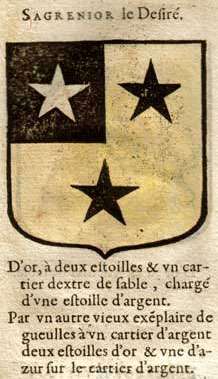Sagramore
Sir Sagramore (also known as Sagremor and many other variations[1]) is a Knight of the Round Table in the Arthurian legend. He appears in standalone and cyclical chivalric romances and other works, including some where he is the titular protagonist. Sagramore's characterisation varies from story to story, but generally he is characterised as a virtuous but hot-tempered knight who fights fiercely and ragefully. He gains a number of nicknames, including "the Hothead" (li Desreez) and "the Desirous" (le Désiré).

Medieval and Renaissance literature
The earliest appearances of Sagramore, as Sagremor, can be found in the stories by Chrétien de Troyes, where he is one of King Arthur's great warriors and champions. In the later Prose Tristan, Sagramore is portrayed as a great friend to the Cornish knight Tristan, and even the one who alerts the rest of the Round Table to his death. In Thomas Malory's Le Morte d'Arthur, Sagramore's prowess varies from situation to situation; he usually serves to lose jousts to better knights, but at times he is a valiant fighter.
Sagramore is also the subject of a fragmentary German romance, Segremors, the surviving portions of which describe his journey to an island ruled by a fay and his undesired combat with his friend Gawain. In Jorge Ferreira de Vasconcelos' 16th-century Portuguese Triunfos de Sagramor (Triumphs of Sagramore) or Memorial das Proezas da Segunda Távola Redonda (Memorial of the Deeds of the Second Round Table), Sagramore and legendary British king Constantine III are fused into a single person, Sagramor Constantino, portrayed as the heir to Arthur who forms a new Round Table to fight the Saxons and keep the glory of Arthurian Britain.[2][3]
Vulgate Cycle
According to the Lancelot-Grail (Vulgate) Cycle, Sagramore was born as the son of the King of Hungary and the daughter of the Eastern Roman Emperor; he was even an heir to the throne of Constantinople. His father died while he was still young, and his mother accepted the proposal of King Brandegoris of Estangore in Britain. When he is fifteen, Sagramore travels to Britain to join them and to become one of King Arthur's knights. Upon arrival in Britain, Sagramore engages Arthur's enemies with aid from Arthur's nephew Gawain and his brothers: they are all subsequently knighted by Arthur.
The Lancelot-Grail describes him as a good knight, but quick to anger. When fighting, he would go into a frenzy not unlike the Irish hero Cúchulainn's warp spasm; when he came down, he would feel ill and hungry. As he was wont to do, Kay gave him a nickname, "Morte Jeune" (Dead Youth), because he would sometimes go into epilepsy-like fits. The Lancelot-Grail recounts a number of his adventures, often centered around rescuing damsels, and mentions that he had a daughter by one of his paramours who was raised at Arthur's court by Guinevere. His half-sister, Brandegoris' beautiful daughter Claire, falls in love with Bors and sleeps with him; their child is Elyan the White. He dies by Mordred's hand as one of Arthur's last remaining warriors in their final battle.
Modern fiction
Sagramore appears with some regularity in modern Arthurian literature and other fiction.
- In Alfred, Lord Tennyson's "Merlin and Vivien", one of the Idylls of the King, he stumbles into bed with a maiden, thinking he is in his own room; to save their reputation the two strangers wed, but their purity and goodness make their marriage a happy one.
- Mark Twain characterised Sagramore (as "Sir Sagramor le Desirous") as an angry, backwards knight in A Connecticut Yankee in King Arthur's Court (portrayed by William Bendix in the 1949 film version), who challenges the Yankee to a duel to the death and is defeated by the Yankee's modern weaponry; his armour, later displayed in a museum featuring a gunshot hole inflicted by the Yankee, serves as a setpiece to the start of the story.
- The knight appears in the musical Camelot and was played by Peter Bromilow in the film version.
- In Bernard Cornwell's The Winter King, "Sagramor" is a fierce Numidian veteran of the old Roman army who has followed Arthur to Britain after the collapse of the Western Roman Empire.
References
- "Sagramore". nightbringer.se. Retrieved 6 December 2018.
- Os livros de cavalarias renascentistas nas histórias da literatura portuguesa, Aurelio Vargas Díaz-Toledo.
- A novelística portuguesa do século XVI, Ettore Finazzi-Agró, Lisbon, Instituto de Cultura Portuguesa, 1978.
Sources
- Norris J. Lacy et al. The New Arthurian Encyclopedia. New York: Garland, 1991.